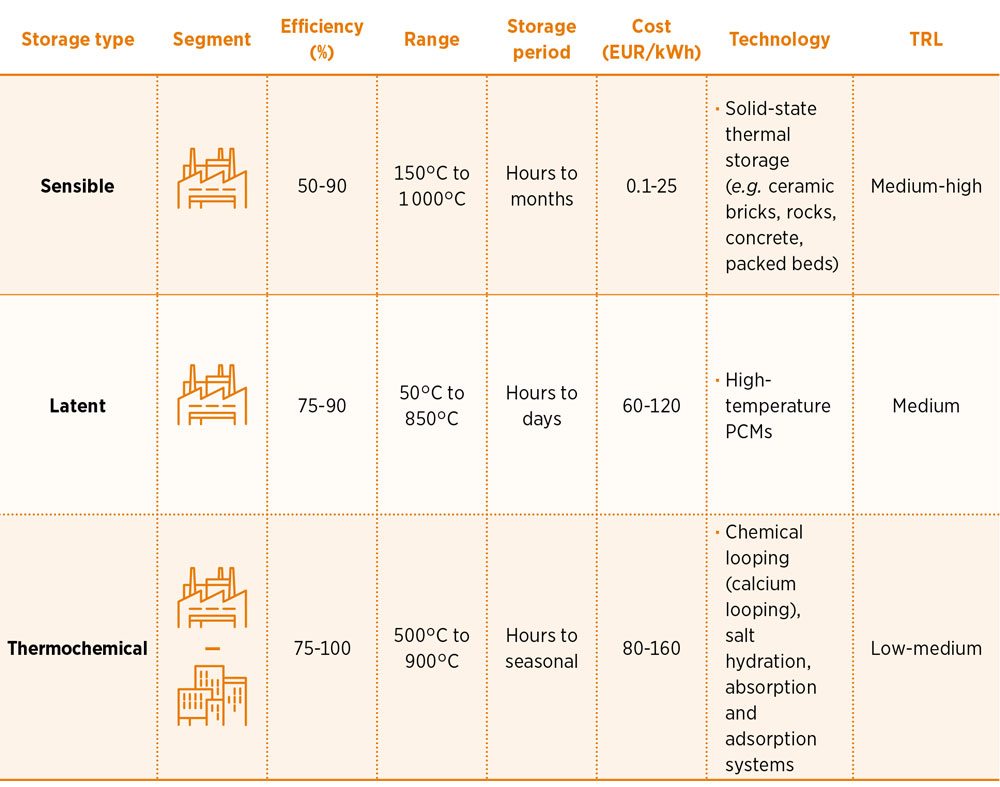Medium- and high-temperature thermal energy storage
Overview of the status and impact of the innovation

What
In high-temperature TES, energy is stored at temperatures ranging from 100°C to above 500°C. High-temperature technologies can be used for short- or long-term storage, similar to low-temperature technologies, and they can also be categorised as sensible, latent and thermochemical storage of heat and cooling (Table 6.4).
TABLE 6.4 High-temperature TES technologies

Why
High-temperature storage offers similar benefits to low-temperature storage (e.g. providing flexibility and lowering costs). However, high-temperature storage is especially useful for smart electrification of heating and cooling in industry, given that many industrial processes either require high temperatures or produce high-temperature heat. Meanwhile, in many cases, industry has relatively steady heat demand over the day; storage would thus play only a small role in meeting demand peaks. Instead, energy could be stored when its prices are low and then discharged when prices are high; this will enable industry players to leverage fluctuating prices and provide valuable demand-response services to the energy system.
BOX 6.7 World’s first Carnot battery stores electricity in heat: Third-life storage plant
The Carnot battery is a promising new concept in electricity storage. It uses heat pumps to convert wind- and solargenerated electricity into heat, which is stored in salts and converted back into electricity using a steam engine generator. Storage temperatures in molten salt can range from 200°C to more than 500°C (Vecchi et al., 2022).
The world’s first Carnot battery prototype is being built in Stuttgart at the Institute of Engineering Thermodynamics within the German Aerospace Centre (DLR) together with the European CHESTER consortium (Compressed Heat Energy Storage for Energy from Renewable Sources).
The battery is based on the CHEST (compressed heat energy storage) process and uses a patented doubleribbed tube heat exchanger to move heat between the heat pump and the heat engine. It can achieve high roundtrip efficiencies of over 50% with low energy losses as it converts electricity into heat and back into electricity (Smallbone et al., 2017). A Carnot battery with a capacity of 1 000 MWh could provide a stable energy supply to a city the size of Stuttgart, while facilitating the coupling of heat and electricity. Further, since Carnot batteries use simple, affordable materials (water and salt), they are more environmentally friendly than conventional batteries. However, achieving high efficiencies requires the maturation of high-temperature heat pump technologies. (German Energy Solutions Initiative, 2020).
Related kits
Power to heat and cooling innovations
Innovations (35)
-
Technology and infrastructure
- 1 Low-temperature heat pumps
- 2 Hybrid heat pumps
- 3 High-temperature heat pumps
- 4 Waste heat-to-power technologies
- 5 High-temperature electricity-based applications for industry
- 6 Low-temperature thermal energy storage
- 7 Medium- and high-temperature thermal energy storage
- 8 Fourth-generation DHC systems
- 9 Fifth-generation DHC systems
- 10 Internet of Things for smart electrification
- 11 Artificial intelligence for forecasting heating and cooling demands
- 12 Blockchain for enabling transactions
- 13 Digitalisation as a flexibility enabler
-
Market design and regulation
- 14 Dynamic tariffs
- 15 Flexible power purchase agreement
- 16 Flexible power purchase agreement
- 17 Standards and certification for improved predictability of heat pump operation
- 18 Energy efficiency programmes for buildings and industry
- 19 Building codes for power-to-heat solutions
- 20 Streamlining permitting procedures for thermal infrastructure
-
System planning and operation
-
Business models
- 28 Aggregators
- 29 Distributed energy resources for heating and cooling demands
- 30 Heating and cooling as a service
- 31 Waste heat recovery from data centres
- 32 Eco-industrial parks and waste heat recovery from industrial processes
- 33 Circular energy flows in cities – booster heat pumps
- 34 Community-owned district heating and cooling
- 35 Community-owned power-to-heat assets